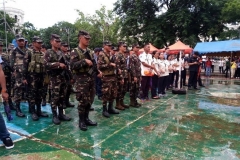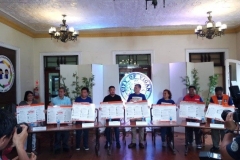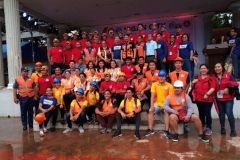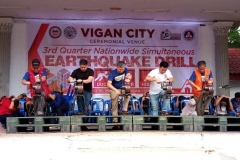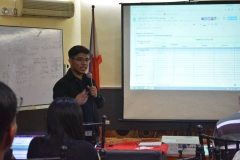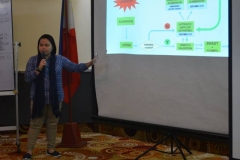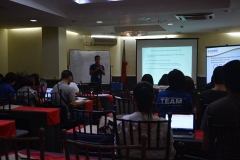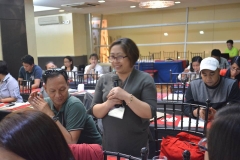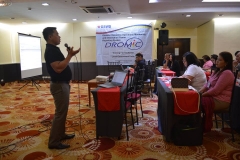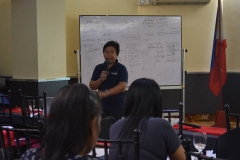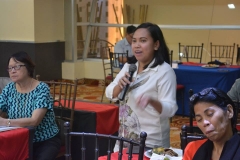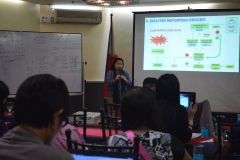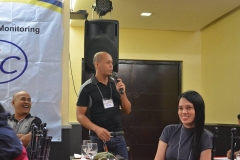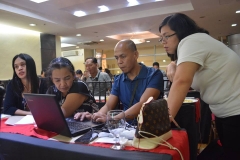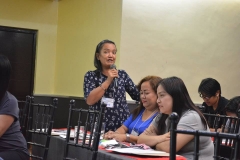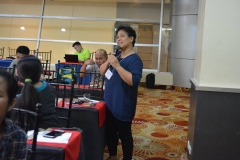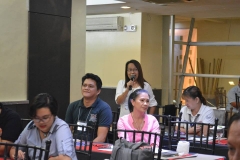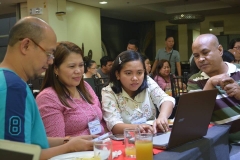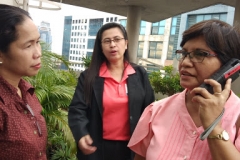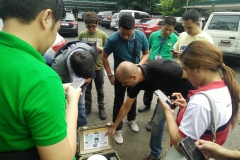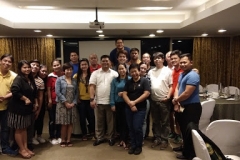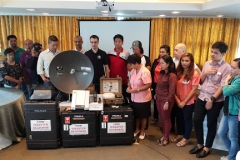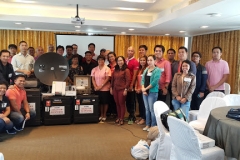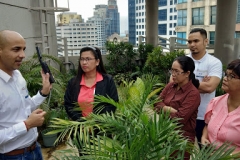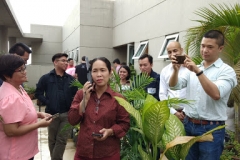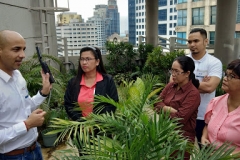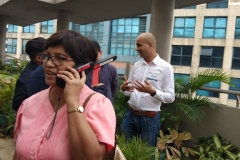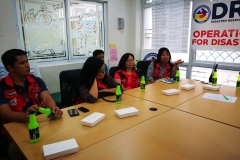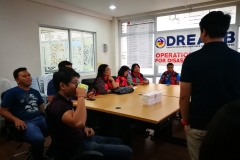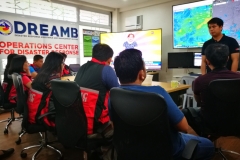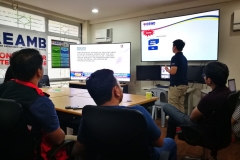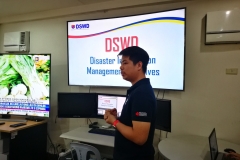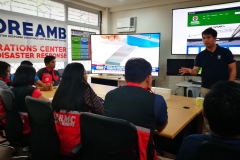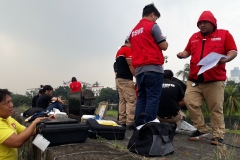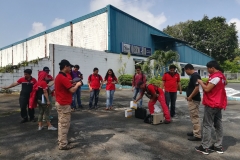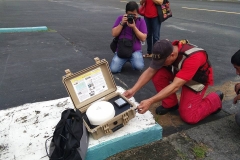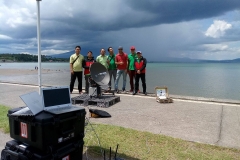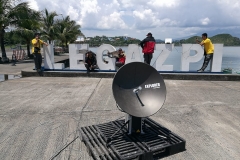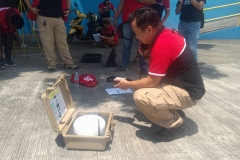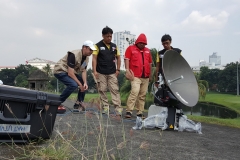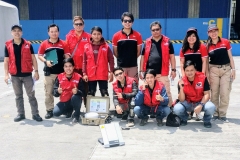DSWD-DRMB Participates in the 3rd Quarter Nationwide Simultaneous EARTHQUAKE DRILL 2018
On 26 August 2018, the National Disaster Risk Reduction and Management Council (NDRRMC) conducted the 3rd Quarter Nationwide Simultaneous Earthquake Drill (NSED). The said activity, which is being conducted quarterly every year since 2015, was hosted by Vigan City, Ilocos Sur.
Vigan City is one of the most vulnerable areas in the Philippines in terms of disasters such as earthquake. PHIVOLCS study shows that the West Ilocos Sur fault system is just less than 10 kilometers from the city. The NSED aims at the preparedness and prevention of every LGU and individuals to respond appropriately in times of disasters, particularly in the eventuality of a magnitude 7.2 earthquake. Said exercise is meant to assess and instill alertness in times of disasters, especially one’s capacities and knowledge on prevention, preparedness, and response when an actual earthquake occurs.
According to the national Office of Civil Defense (OCD), a total of 3,000 national and local government officials, responders, and community members participated in the earthquake drill at Vigan City’s Plaza Burgos as the ceremonial area. Various scenarios during the drill focused on the impacts of a magnitude of 7.2 earthquake generated along the Abra River Fault at the Heritage Village of Vigan City.
On behalf of DSWD Acting Secretary Virginia N. Orogo and the DSWD Disaster Response Management Group (DRMG), DRM Bureau Director, Rodolfo M. Encabo participated in the said activity. In his short message, he mentioned: “Ito po ang isa sa main advocacy ng ating Prisedente ngayon. In fact this year mayroon pong pinaghahandaan sa ating Kongreso na bagong itatatag na departamento: and Department of Disaster Resiliency Management. Ito po ang kagustuhan ng ating Presidente, na magkaroon ng ahensyang tututok para sa paghahanda sa lahat ng LGUs.”
After the short messages shared by the Ilocos Sur Provincial Governor Ryan Luis Singson, Ilocos Sur Mayor Juan Carlo Medina, and other national agencies such as NDRRMC, OCD, and DOST-PHIVOLCS, the representative of each of these offices started to switch the hand of the siren to mark the start of the drill at exactly 2PM. Vigan City Mayor Juan Carlo Medina led the Emergency Response Cluster, Incident Management Team, and Rapid Damage Assessment and Needs Analysis Team, aside from the Policemen, Firemen and Rescue Teams. They also took full control of operating their Emergency Operation Center, Treatment Area and Incident Command Post.
The agenda ended with a Press Conference. Mayor Medina admitted that this activity has a lot of room for improvement but the drill went successful as planned. The main agenda was to save lives from any disaster that may occur. In addition, he said that they are coordinating with the owners of the establishment that have not yet been renovated.
The final query during the press-con was addressed to DRMB Director Encabo, on how the goods will be sent and the certainty that the relief goods would not be spoiled, as what happened during super-typhoon Yolanda. Dir. Encabo explained that DSWD has a plan in place to establish production hubs in strategic areas in Luzon, Visayas, and Mindanao with mechanized production, so that the travel time of the relief goods will not be a problem, and spoilage of goods would be avoided.
In general, the 3rd Quarter NSED fared very well.
All national and local government offices engaged gave their full cooperation in the event; and all local participants took the drill seriously and responsibly, aiming at the goal to save lives, towards promoting a resilient community, local government unit, and nation as a whole. (Mariel Ferrariz / mppb / DROMIC)
DROMIC TRAINING AND CONSULTATION WORKSHOP FOR THE ENHANCEMENT OF DISASTER REPORTING SYSTEM @ Greenhills Elan Hotel, Annapolis Street, San Juan City, Metro Manila
As part of the initiatives of DSWD FO NCR Disaster Response Management Division (DRMD) to create a systematized reporting mechanism during disasters and emergencies, DSWD CO DROMIC was invited to be part of their Training Team as Resource Persons (RPs) in the conduct of their DROMIC Training and Consultation Workshop for the Enhancement of Disaster Reporting System for two (2) batches of their target participants: the First Batch was for their City / Municipal Action Teams (C/MATs) on 31 July – 02 August 2018; and the Second Batch was for their NCR LGU Disaster Focals on 08 – 10 August 2018. Both Trainings were held at Greenhills Elan Hotel in San Juan City, Metro Manila.
The goal of the activity was for DSWD FO-NCR to have a systematized disaster reporting mechanism among its C/MATs and LGU Disaster Focals, towards effective and efficient disaster preparedness and response.
Specifically, the training aimed to provide orientation and technical assistance along the Disaster Response Operations Monitoring and Information Center (DROMIC) Reporting Guidelines; provide the essential technical know-how on the use of DROMIC reporting templates; discuss on the tasks and responsibilities of all staff involved in the preparation of DROMIC reports and their salient roles and responsibilities in disaster response; establish a reporting system and a DROMIC team of FO-NCR as lead in reporting during disasters / emergencies; and cascade the DROMIC Guidelines to the 17 LGUs, to assist and guide them in preparation of reports during disasters / emergencies.
The “Provision of Technical Assistance and Resource Augmentation to Field Offices in the Management of Disaster Response Information” is one of the mandated functions of DSWD CO DROMIC. Thus, together with the DSWD FO NCR DRMD Team headed by their OIC Division Chief, Mr. Bienvenido Barboza and FO-NCR DROMIC Focal, Ms. Norjanisa Airah Calaca, three (3) DROMIC Staff from the Central Office: Ms. Mapet Bulawan, Mr. Marc Leo Butac, and Mr. Rodel Cabaddu: served as RPs for the 1st and 2nd batches, respectively.
Highly remarkable in the expectations, especially of the LGU DRR Focal Participants – who are the primary, official disaster data sources – is the clamor that there be a “comprehensive / unified / standard DROMIC Reporting Guidelines and Systems towards achieving accurate, timely, reliable, and well-targeted disaster information”.
Highlights of the training – workshop are topics on: The DROMIC History and its Current Set-up; The Proposed FO-DRMD; The RA 10821; The DROMIC Reporting Guidelines; The DROMIC Reporting Templates with Simulation Exercises; Consultation on the Creation of FO-NCR DROMIC Team; and Commitment Setting & Ways Forward.
The energetic facilitation of the FO NCR DRMD enthused active engagement of the participants in the discussions and simulation exercises, making the experiences worth learning with fun.
Kudos to all for making the activity a success! (Mapet P. Bulawan)
DSWD CO & FO MiMaRoPa Training on the Use and Operation of Inmarsat-donated Equipment
Ongoing ATM: DSWD CO & FO MiMaRoPa Training on the Use and Operation of Inmarsat-donated Equipment @ Linden Suites, Ortigas Center, Pasig City; 06 – 09 August 2018
This training is part of enhancing the Emergency Response capabilities of the DSWD Field Offices, through DSWD’s partnership with Inmarsat (international maritime satellite) of UK, the leader in global mobile satellite communications.
“The Inmarsat is a British satellite telecommunications company, offering global mobile services. It provides telephone and data services to users worldwide, via portable or mobile terminals which communicate with ground stations through thirteen geostationary telecommunications satellites. Inmarsat’s network provides communications services to a range of governments, aid agencies, media outlets and businesses (especially in the shipping, airline and mining industries) with a need to communicate in remote regions or where there is no reliable terrestrial network. The company is listed on the London Stock Exchange, is a constituent of the FTSE 250 Index, and is a financial and technical sponsor of Télécoms Sans Frontières” (cf https://en.wikipedia.org/wiki/Inmarsat)
Since last year, Inmarsat has established partnership with DSWD, to aid in its information and communications in disaster response. They have donated a set of telecommunication equipment, which have been deployed to five (5) DSWD Field Offices for pilot implementation – one of which is DSWD FO MiMaRoPa. Together with the donated equipment, Inmarsat representatives from UK have come to the Philippines to capacitate the DSWD Central and Field Office Rapid Emergency Telecommunications Team (RETT) and DRMB in the proper use and operations of the said equipment. To ensure accountability of the recipient FOs, proper turn-over and acceptance are conducted and documented.
During this training, DSWD FO MiMaRoPa Regional Director, Wilma Naviamos, together with their DRMD OIC-Division Chief, Ms. Sheila Tapia gratefully received the set of donated equipment, which were ceremonially turned-over by DSWD CO, represented by DRMB-DROMIC Head, Ms. Mapet Bulawan; and the Inmarsat Team of Trainors: Mr. Oscar Lizardo – Inmarsat Project Manager to the Philippines; Mr. Deep Sundriyal – Inmarsat Training Head; and Mr. Sebastien Latouille – from Télécoms Sans Frontières. A formal turn-over will be further done at the DSWD MiMaRoPa Field Office.
The participants from DSWD CO and FO MiMaRoPa are actively participating in the discussions and hands-on training and simulation exercises, and enjoying every learning experience. Notable, indeed, is the very energetic participation of Dir. Naviamos, especially during the hands-on training, where she contacted her SWAD Team Leaders in Palawan and Mindoro, using the satphone as part of the drill.
DSWD DRMB Director, Rodolfo Encabo also took time out of his very hectic schedules at the CO to be present with the participants; share emerging updates on DRMB; appreciate their dedicated efforts in their disaster response; and inspire them to carry on.
Said training is organized by DSWD-DRMB-DROMIC.
DSWD Intervention to Families Affected by Tropical Depression Josie in MiMaRoPa
Provincial Government of Davao del Norte visits DReMB Operations Center for Benchmarking Activity
On 13 March 2018, delegates from the Provincial Government of Davao del Norte visited the Disaster Response Management Bureau (DReMB) Operations Center for a benchmarking activity. In the said activity, members of the Provincial Quick Response Team were introduced to the different Information Management initiatives of the Disaster Response Operations Monitoring and Information Center (DROMIC).
The guests were given a general picture of the RA 10121 or the Philippine Disaster Risk Reduction and Management (DRRM) Act of 2010 and how the DSWD is the Vice-Chair for the Disaster Response pillar. As so, the Department is the Cluster Lead for the Camp Coordination and Camp Management (CCCM) cluster, Internally Displaced Persons (IDP) Protection cluster, and Food and Non-food Items (FNI) cluster.
Further, the DROMIC reporting process was discussed with the guests and how it is currently in the process of being enhanced through the Disaster Response Operations Monitoring Information System (DROMIS) and Family Access Card during Emergencies (FACE).
Also, the guests were introduced to the Predictive Analytics for Humanitarian Response (PAHR) and how it is utilized as the main tool by the Department for planning the appropriate response to an oncoming hazard. They were shown examples of previous PAHRs such as for the Super Typhoon “Lawin” and “The Big One” or the 7.2-Magnitude Earthquake that could potentially hit Metro Manila and nearby provinces.
The activity ended with the Provincial Government of Davao del Norte looking forward to absorbing the technologies that the DReMB has, in order to better equip their Operations Center with a more sophisticated system of capturing and reporting data.
DSWD Receives State-of-the-Art Satellite Telecommunications Equipment for Disaster Response from Inmarsat
In times of disaster, relief comes in the form of food, water, shelter, clothing, and the ability to communicate and access information.
The Department of Social Welfare and Development (DSWD) in partnership with Inmarsat, the global mobile satellite communications, is providing the Philippines with the latest state-of-the-art satellite connectivity and equipment for use during disaster response.
The partnership was made possible by the United Kingdom Space Agency (UKSA) International Partnership Programme (IPP). This IPP Project aims to improve disaster management operations by providing the most powerful satellite equipment available. This will enable disaster responders to establish telecommunications for the quick delivery of life-saving information in a manner that was not possible in the past.
The equipment will be deployed to DSWD’s Field Offices, which should enhance the response capacities at that level and bring rapid response closer to communities affected by disasters.
According to Director Felino O. Castro V, Head of the Disaster Response Assistance and Management Bureau (DReAMB) of the DSWD, “The bedrock of prompt and effective response is the ability to communicate and access reliable, accurate, and timely information, before, during, and after a disaster, at all levels of response governance.”
The pilot area will be in the Bicol Region (DSWD Field Office V) given their exposure to various kinds of hazards. Four other regions will receive the satellite telecommunications equipment later in 2018.
The partnership agreement with Inmarsat has granted satellite phones, manual and auto-pointing Broadband Global Area Network (BGAN) terminals, and Global Xpress terminals, a powerful and highly portable satellite terminal which can provide high speed internet connectivity even in remote locations in the country.
Myanmar Relief and Resettlement Department (RRD) Study Visit to the Philippines
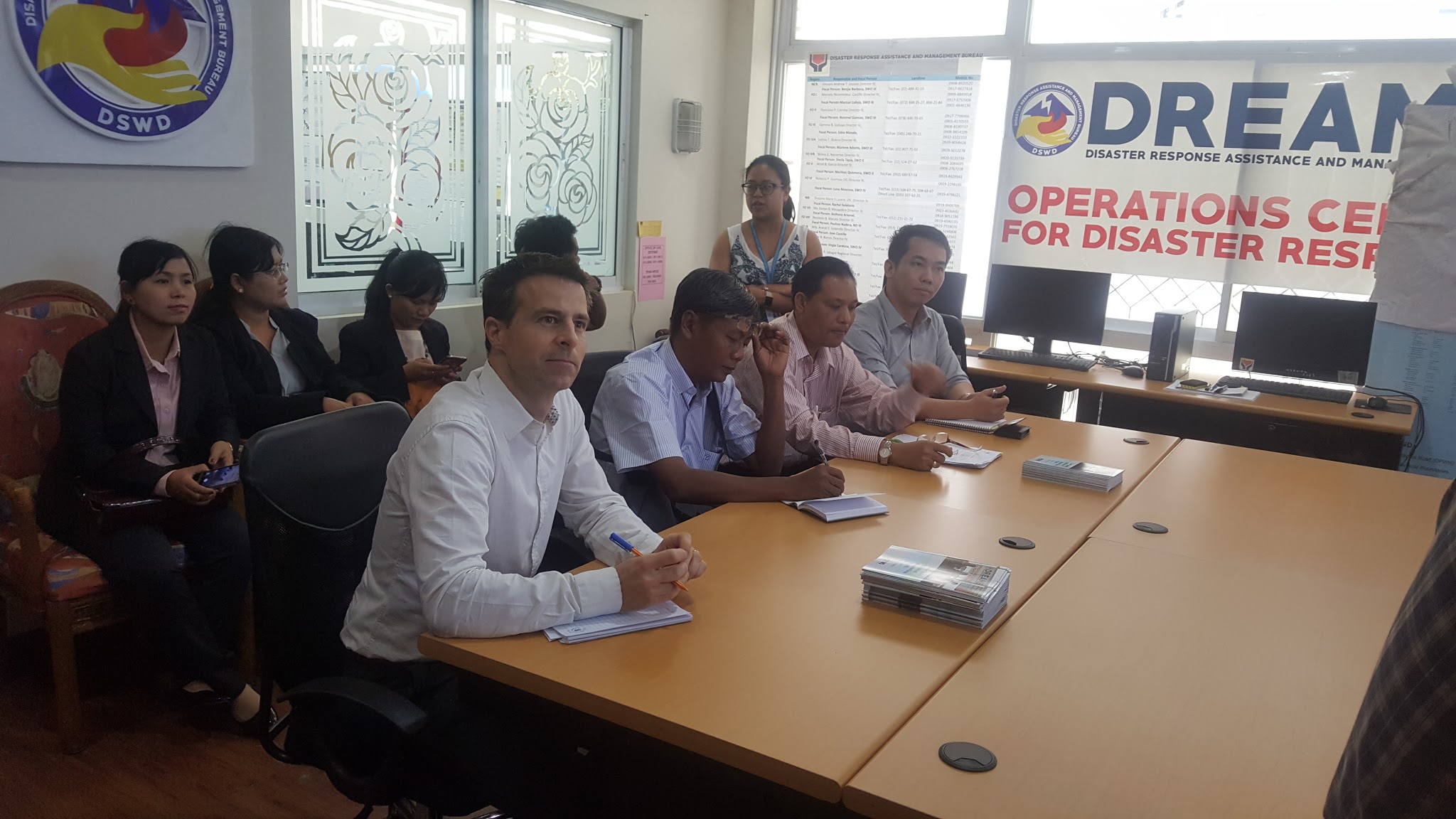
28 March 2017 – The Disaster Response Operations Monitoring and Information Center (DROMIC) presented the country’s emergency preparedness and response framework as part of a study visit by the Myanmar Relief and Resettlement Department (RRD).
During the presentation, the Department was introduced as being the executive Department of the Philippine Government responsible for the protection of social welfare rights and the promotion of social development of Filipinos. The presentation continued on to introduce the different programs by the Department.
Shortly thereafter, the RA 10121 or the Philippine DRRM Act of 2010 was discussed wherein the Department is entrusted to be the Vice-Chair for Disaster Response of the National Disaster Risk Reduction and Management Council (NDRRMC). Given this, the Department is mandated to provide life preservation and meet the basic subsistence needs of affected population based on acceptable standards during or immediately after a disaster.
The country was then introduced as ranking third (1994-2013) in terms of being the most disaster-affected countries in the world with hydro-meteorological hazards such as floods and storms topping the list of the most common hazards that affect Filipinos. Also noteworthy is the fact that the top 10 disasters that have hit the country occurred in the last two decades.
Hence in this “new normal” that the country is faced with where weather patterns have changed and natural events are increasingly menacing, the Predictive Analytics for Humanitarian Response (PAHR) was showcased. PAHR is the crystal ball, so to speak, of the Department in order to prepare for the appropriate level of response whenever there are potential disaster events. It is all about making predictions using mathematical theories, scientific processes, and spatial technologies based on current and historical data. In a nutshell, Disaster Imagination is what it is and asks questions “What could possibly happen?” “Where could it possible happen?” and “How many will be affected should it happen?”
Results of the PAHR for Lawin (I.N. Haima) was also presented where it was stressed that the figures from the results were not far off compared to the actual figures from when it already made landfall and ravaged much of Northern Luzon. This was followed by the presentation of the PAHR for the “the big one” or the 7.2-magnitude earthquake that could hit Metro Manila and nearby provinces.
As a next step for PAHR, its version 3.0 will be a tool with artificial intelligence which will self-analyze all results that will be put into it. This means that as more disasters happen, the more it can profile an area and, in effect, the more realistic it can predict what could happen to that area at any given potential disaster event scenario.
United Nations-Office for the Coordination of Humanitarian Affairs (UN-OCHA) Asia Pacific Regional Information Management Workshop
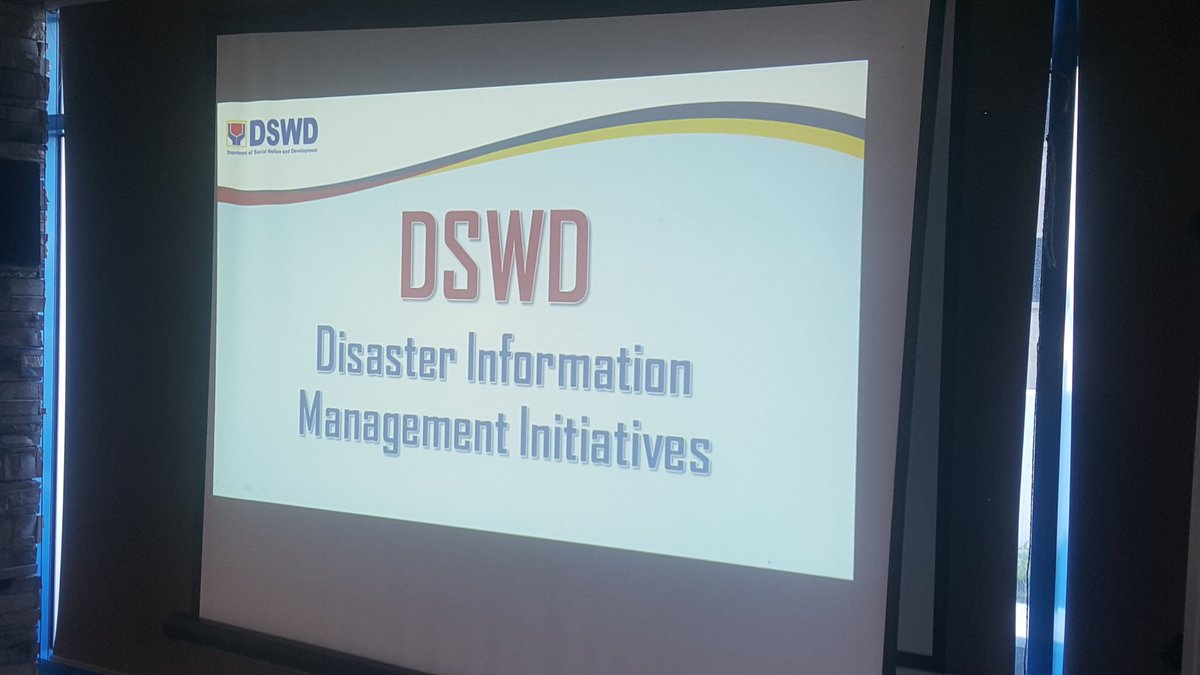

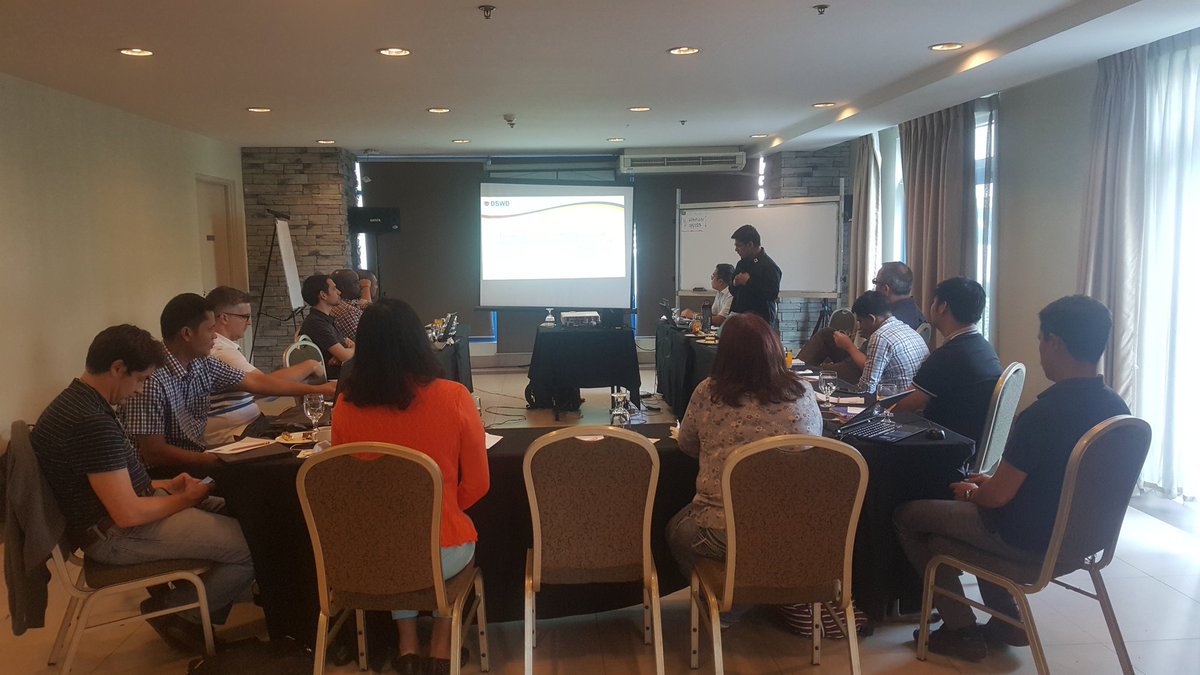
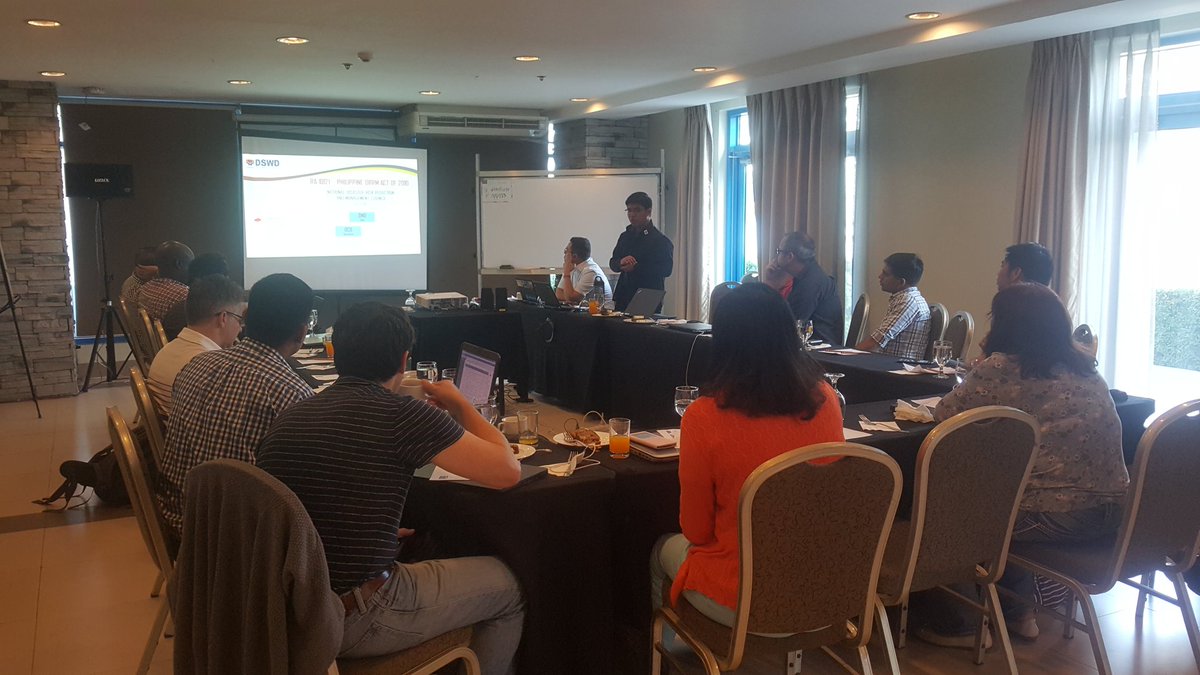
24 March 2017 – The Disaster Response Operations Monitoring and Information Center (DROMIC) presented DSWD’s Disaster Information Management Initiatives during the United Nations-Office for the Coordination of Humanitarian Affairs (UN-OCHA) Asia Pacific Regional Information Management Workshop.
During the presentation, the Department was introduced as being the executive Department of the Philippine Government responsible for the protection of social welfare rights and the promotion of social development of Filipinos. The presentation continued on to introduce the different programs by the Department.
Shortly thereafter, the RA 10121 or the Philippine DRRM Act of 2010 was discussed wherein the Department is entrusted to be the Vice-Chair for Disaster Response of the National Disaster Risk Reduction and Management Council (NDRRMC). Given this, the Department is mandated to provide life preservation and meet the basic subsistence needs of affected population based on acceptable standards during or immediately after a disaster.

The current data flow of disaster information was also presented as shown in the photo above. As it stands, it is an extensive process where the data comes from the field and then validated in the Department’s Field Offices (FOs). These reports are then submitted to the Central Office (CO) to be validated, again, by the DROMIC before being processed into reports that are open to the public. In answer to this, the DROMIC is in the midst of providing Technical Assistance and Consultations to FOs and LGUs regarding disaster reporting and the use of Disaster Assistance Family Access Card (DAFAC). These efforts hope to gather as much inputs as possible in order to come up with the Disaster Response Operations Monitoring Information System (DROMIS) and the Family Access Card for Emergencies (FACE). These information technologies aim to allay disaster reporting and expedite the data flow pictured above.
Another highlight of the presentation was when the Predictive Analytics for Humanitarian Response (PAHR) was showcased. PAHR is the crystal ball, so to speak, of the Department in order to prepare for the appropriate level of response whenever there are potential disaster events. It is all about making predictions using mathematical theories, scientific processes, and spatial technologies based on current and historical data. In a nutshell, Disaster Imagination is what it is and asks questions such as “What could possibly happen?” “Where could it possible happen?” and “How many will be affected should it happen?”
Also, the current policy requires ₱3 million for Standby Funds and 30,000 family food packs (FFPs) for Stockpile for all regions. Using PAHR, the allocation of Standby Funds and Stockpile will be based on the risk profile of each respective regions. This will ensure that more resources will be allocated to regions that are more frequently visited and most affected by disaster events. PAHR can be used in identifying areas that are possible to be affected as well as the number of people. Hence, preparations on the location and amount of prepositioned goods can be carried out before the disaster even happens.
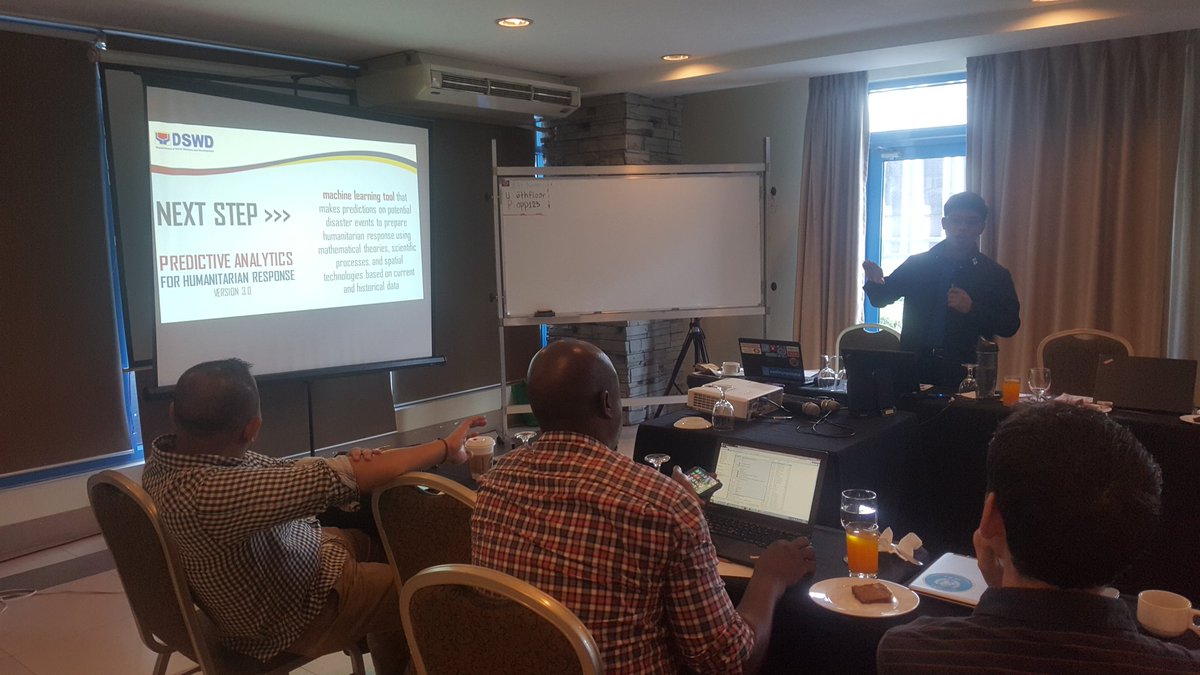
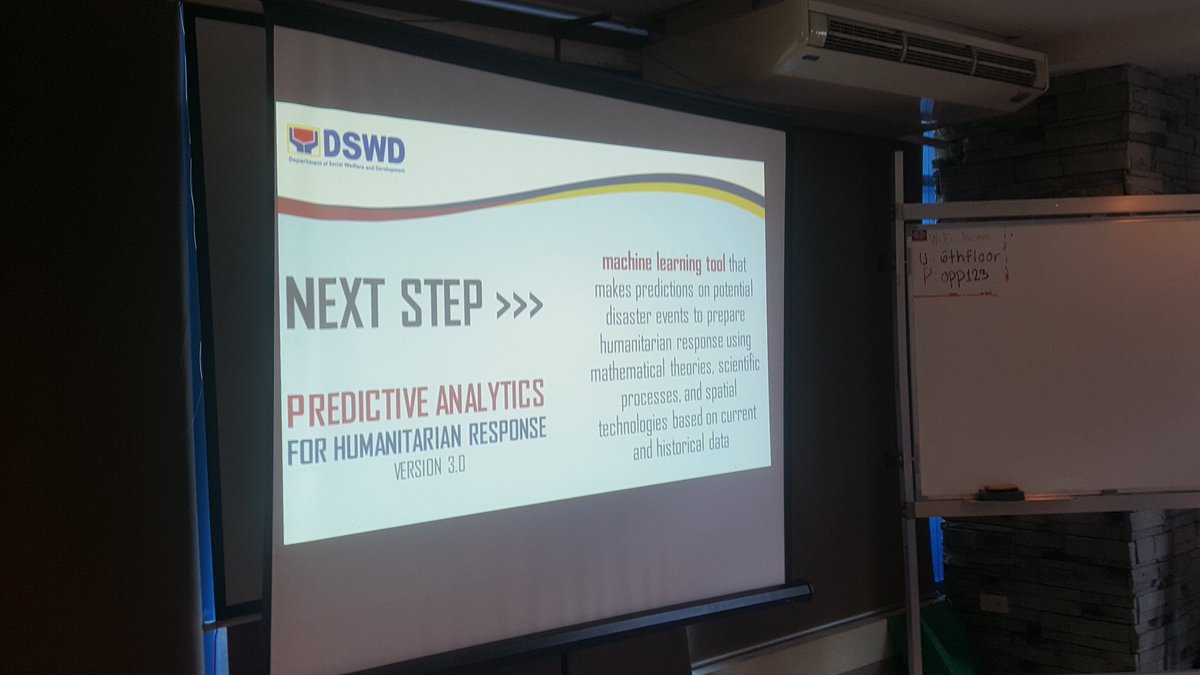
As a next step for PAHR, its version 3.0 will be a tool with artificial intelligence which will self-analyze all results that will be put into it. This means that as more disasters happen, the more it can profile an area and, in effect, the more realistic it can predict what could happen to that area at any given potential disaster event scenario.


